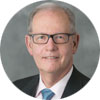Download PDF

There are very few Americans who haven’t heard of Dr. Anthony Fauci. He’s inspired bobblehead dolls, a mixed drink (the Fauci Pouchy), and even Fauci doughnuts. He will be remembered most for his leadership during our current pandemic. Since 1984 he has been the Director of the National Institute of Allergy and Infectious Diseases of the National Institutes of Health (NIH), and in that capacity he has played a pivotal role in directing research and public health initiatives combatting infectious diseases including HIV/AIDS, SARS, swine flu, and Ebola. As an NIH Director, he can be an articulate spokesperson for science, an advocate for careful scientific methodology, and a transformative leader in setting research priorities and directions.
Ophthalmology is delighted to welcome its new NIH Director—its Anthony Fauci, if you will. The selection of Michael F. Chiang, MD, as the new Director of the National Eye Institute (NEI) was announced by the NIH in late July.He will serve as only the third Director of the NEI since it was established by Congress in 1968, succeeding Paul Sieving, MD, PhD, who very successfully led the institute since 2001.
For physicians, the NIH and its component institutes seem, in normal times, to function quietly in the background “doing research.” However, it is during times of scientific upheaval that their true role and impact become particularly evident.
Dr. Chiang will oversee an annual NEI budget of over $800 million and hundreds of staff. The institute will provide annual funding for over 1,600 research grants to thousands of scientists at more than 250 global institutions. He will also direct basic, translational, and clinical research programs at the NIH campus in Bethesda, Maryland, and postdoctoral training programs for hundreds of fellows. This is not a small footprint!
The NEI has provided funding and leadership for such landmark clinical trials as the Diabetic Retinopathy Study, the Age-Related Eye Disease Study, the Ocular Hypertension Treatment Study, and four major retinopathy of prematurity treatment trials. Its scientists cloned the RPE65 gene, solved the 3-D structure of rhodopsin, and catalyzed retinal neuroregeneration research through its Audacious Goals Initiative. Every practicing ophthalmologist employs the fruits of NEI-funded research every day.
Mike Chiang is an ideal ophthalmologist to lead the NEI at this critical time. He’s an innovative investigator who is responsible for over 200 peer-reviewed journal papers. He is a skilled and busy pediatric ophthalmologist and has taught countless medical students, residents, fellows, and graduate students. In addition to this, Mike is an associate editor of two journals and on the editorial boards of three more, including Ophthalmology and EyeNet. He has served on the Academy’s Board of Trustees, as chair of our Medical Information Technology Committee, chair of the Task Force on Artificial Intelligence, and chair of the IRIS Registry Analytics Committee. To take his new post, he is leaving his position as Professor of Ophthalmology & Medical Informatics and Clinical Epidemiology at Oregon Health & Science University and the Casey Eye Institute in Portland.
Mike Chiang is not just a scientist, clinician, and professional leader but also one of ophthalmology’s most thoughtful experts in artificial intelligence, clinical telemedicine, clinical workflow modeling, and population health and big data analytics at a time when the fields are exploding with new discoveries. (See this issue’s cover story.) As NEI Director he will help set research priorities and play a pivotal role in explaining vision science and its impact on patient lives to policy makers and national political leaders. The Academy will partner with him as we support funding for vision research.
I can think of no one better to take the helm of one of our most important professional institutions at this time and to represent all of us as a trusted voice of science in Washington.